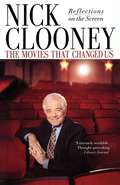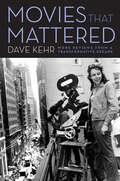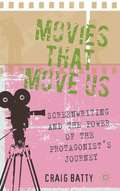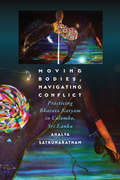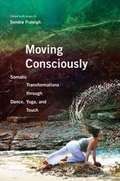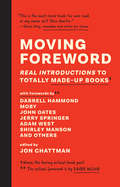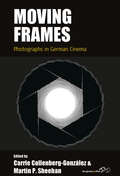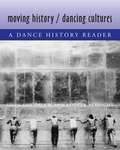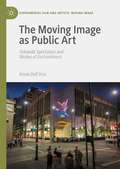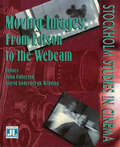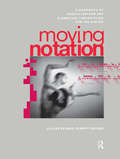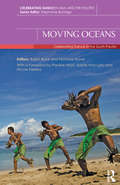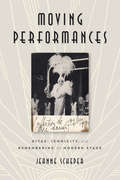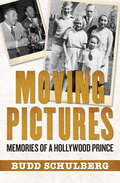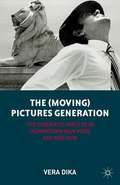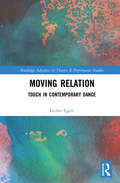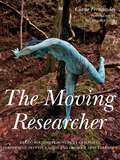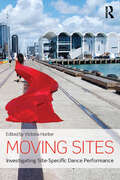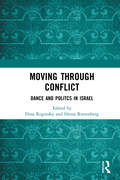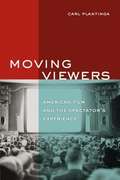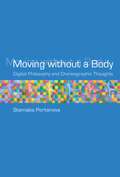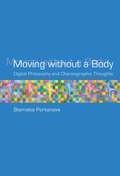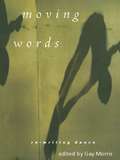- Table View
- List View
The Movies That Changed Us: Reflections On The Screen
by Nick ClooneyTwenty movies that had an impact on society.
The Movies That Changed Us: Reflections on the Screen
by Nick ClooneyThere are movies we love, but only one movie in a thousand actually changes the way we live, the way we look at life, or the way we define entertainment. Broadcast journalist Nick Clooney, best known as the silver-haired movie host on the cable channel American Movie Classics, has selected twenty movies that changed us, some for the better, some for the worse. He starts with the recent past: Saving Private Ryan, a movie that changed the way people across the world view the American generation that fought World War Two; Star Wars, a motion picture so important that a missile defense system was named for it; and The Birth of a Nation, not only the first film to be hailed as the artistic equivalent to opera, literature, and painting, but also the first film to give a cloak of respectability to racial prejudice. Clooney's debate-starting distinctions will engage, delight, and challenge everyone who loves movies: Did Taxi Driver change the way we view individual violence? Did The Graduate change the way we view romance? Did Dr. Strangelove change the way we contemplate mass destruction? Did The Best Years of Our Lives alter our behavior toward veterans? And did Triumph of the Will almost help the Nazis win the war? Clooney ends with an epilogue on "The Movie That Never Was": the film that could have spurred the civil rights movement if only it had been made. "Sports changed things, the military changed things, and eventually the federal government changed things," Clooney writes, but in the matter of race, he concludes, the movies changed nothing. Thought-provoking, entertaining, and compulsively readable, The Movies That Changed Us will delight film fans of every generation.
Movies That Mattered: More Reviews from a Transformative Decade
by Dave KehrDave Kehr’s writing about film has garnered high praise from both readers and fellow critics. Among his admirers are some of his most influential contemporaries. Roger Ebert called Kehr “one of the most gifted film critics in America.” James Naremore thought he was “one of the best writers on film the country as a whole has ever produced.” But aside from remarkably detailed but brief capsule reviews and top-ten lists, you won’t find much of Kehr’s work on the Internet, and many of the longer and more nuanced essays for which he is best known have not yet been published in book form. With When Movies Mattered, readers welcomed the first collection of Kehr’s criticism, written during his time at the Chicago Reader. Movies That Mattered is its sequel, with fifty more reviews and essays drawn from the archives of both the Chicago Reader and Chicago magazine from 1974 to 1986. As with When Movies Mattered, the majority of the reviews offer in-depth analyses of individual films that are among Kehr’s favorites, from a thoughtful discussion of the sobering Holocaust documentary Shoah to an irresistible celebration of the raucous comedy Used Cars. But fans of Kehr’s work will be just as taken by his dissections of critically acclaimed films he found disappointing, including The Shining, Apocalypse Now, and Raiders of the Lost Ark. Whether you’re a long-time reader or just discovering Dave Kehr, the insights in Movies That Mattered will enhance your appreciation of the movies you already love—and may even make you think twice about one or two you hated.
Movies That Move Us
by Craig BattyFrom a screenwriting perspective, Batty explores the idea that the protagonist's journey is comprised of two individual yet interwoven threads: the physical journey and the emotional journey. His analysis includes detailed case studies of the films Muriel's Wedding , Little Voice , Cars , Forgetting Sarah Marshall , Sunshine Cleaning and Up.
Moving Bodies, Navigating Conflict: Practicing Bharata Natyam in Colombo, Sri Lanka
by Ahalya SatkunaratnamMoving Bodies, Navigating Conflict is a groundbreaking ethnographic examination of dance practice in Colombo, Sri Lanka, during the civil war (1983–2009). It is the first book of scholarship on bharata natyam (a classical dance originating in India) in Sri Lanka, and the first on the role of this dance in the country's war. Focusing on women dancers, Ahalya Satkunaratnam shows how they navigated conditions of conflict and a neoliberal, global economy, resisted nationalism and militarism, and advocated for peace. Her interdisciplinary methodology combines historical analysis, methods of dance studies, and dance ethnography.
Moving Consciously: Somatic Transformations through Dance, Yoga, and Touch
by Sondra FraleighThe popularity of yoga and Zen meditation has heightened awareness of somatic practices. Individuals develop the conscious embodiment central to somatics work via movement and dance, or through touch from a skilled teacher or therapist often called a somatic bodyworker. Methods of touch and movement foster generative processes of consciousness in order to create a fluid interconnection between sensation, thought, movement, and expression. In Moving Consciously , Sondra Fraleigh gathers essays that probe ideas surrounding embodied knowledge and the conscious embodiment of movement and dance. Using a variety of perspectives on movement and dance somatics, Fraleigh and other contributors draw on scholarship and personal practice to participate in a multifaceted investigation of a thriving worldwide phenomenon. Their goal: to present the mental and physical health benefits of experiencing one's inner world through sensory awareness and movement integration. A stimulating addition to a burgeoning field, Moving Consciously incorporates concepts from East and West into a timely look at life-changing, intertwined practices that involve dance, movement, performance studies, and education. Contributors: Richard Biehl, Robert Bingham, Hillel Braude, Alison East, Sondra Fraleigh, Kelly Ferris Lester, Karin Rugman, Catherine Schaeffer, Jeanne Schul, and Ruth Way.
Moving Foreword: Real Introductions to Totally Made-Up Books
by Jon ChattmanA great foreword is more than just a few pages of self-indulgent frippery that comes before a book. A great foreword adds zest. It sets the stage for the page turner you're about to open, and perhaps even puts you in the locked room where a mystery happens or in the high-button shoes of a year gone by. A great foreword—sometimes—is even better than the book it precedes. So why not skip the boring actual-book part? Moving Foreword is a collection of introductions to imaginary books, written by real celebrities, comedians, musicians, and other writers with something to say. With a real foreword by Rainn Wilson, this book offers a no-holds-barred cacophony of laugh-out-loud funny, poignant, and thought-provoking writing that tackles everything from politics to pop culture, true crime to trout fishing, and Star Wars to skin flicks. Highlights include: • Bustin' Through: Confessions of a Kool-Aid Man Foreword by "Pop Candy" columnist Whitney Matheson • Phil Rosenthal's Who's the Boss?: My Unlikely Rise to Rock Stardom Foreword by "Bruce Springsteen" (Phil Rosenthal) • Keep Your Gaze on Me: A True Story of Social Media, Obsession, and Murder Foreword by Shirley Manson, lead vocalist of Garbage • Sock Puppet Mozart: The Life and Gruesome Death of Randy Masterson Foreword by actor Thomas Lennon • Vance DeGeneris: An Unauthorized Biography Foreword by Vance DeGeneres • Everything You Need to Know About Massachusetts Fish and Wildlife Regulations Foreword by New Kids on the Block member Jonathan Knight • Fly Ball: How the New York Yankees Have Changed Lives Foreword by talk show host Jerry Springer • Terrible Band Names: A Chronology of Rock History Foreword by John Ondrasik, a.k.a. Five for Fighting • God's Wow, You're All F***ing This Up Big Time Foreword by singer-songwriter Mary Lambert . . . any many more!
Moving Frames: Photographs in German Cinema (Film Europa #26)
by Carrie Collenberg-González Martin P. SheehanAs the building blocks of moving pictures, photographs have played an integral role in cinema since the dawn of the medium—a relationship that has grown more complexly connected even as the underlying technologies continue to evolve. Moving Frames explores the use of photographs in German films from Expressionism to the Berlin School, addressing the formal and narrative roles that photographs play as well as the cultural and historical contexts out of which these films emerged. Looking beyond and within the canon, the editors gather stimulating new insights into the politics of surveillance, resistance, representation, and collective memory functioning through photographic rupture and affect in German cinema.
Moving History/Dancing Cultures
by Ann Cooper Albright Ann DilsThis new collection of essays surveys the history of dance in an innovative and wide-ranging fashion. Editors Dils and Albright address the current dearth of comprehensive teaching material in the dance history field through the creation of a multifaceted, non-linear, yet well-structured and comprehensive survey of select moments in the development of both American and World dance. This book is illustrated with over 50 photographs, and would make an ideal text for undergraduate classes in dance ethnography, criticism or appreciation, as well as dance history--particularly those with a cross-cultural, contemporary, or an American focus. The reader is organized into four thematic sections which allow for varied and individualized course use: Thinking about Dance History: Theories and Practices, World Dance Traditions, America Dancing, and Contemporary Dance: Global Contexts. The editors have structured the readings with the understanding that contemporary theory has thoroughly questioned the discursive construction of history and the resultant canonization of certain dances, texts and points of view. The historical readings are presented in a way that encourages thoughtful analysis and allows the opportunity for critical engagement with the text. Ebook Edition Note: Ebook edition note: Five essays have been redacted, including "The Belly Dance: Ancient Ritual to Cabaret Performance," by Shawna Helland; "Epitome of Korean Folk Dance", by Lee Kyong-Hee; "Juba and American Minstrelsy," by Marian Hannah Winter; "The Natural Body," by Ann Daly; and "Butoh: 'Twenty Years Ago We Were Crazy, Dirty, and Mad',"by Bonnie Sue Stein. Eleven of the 41 illustrations in the book have also been redacted.
The Moving Image as Public Art: Sidewalk Spectators and Modes of Enchantment (Experimental Film and Artists’ Moving Image)
by Annie Dell'AriaThis book maps the presence of moving images within the field of public art through encounters with passersby. It argues that far from mere distraction or spectacle, moving images can produce moments of enchantment that can renew, intensify, or challenge our everyday engagement with public space and each other. These artworks also offer frameworks for understanding how moving images operate in public space—how they move viewers and reconfigure the site of the screen. Each chapter explores a mode of address that examines how artists and curators leverage the moving image’s attentional power to engage audiences, create spaces, make place, and challenge assumptions. This book also examines the difficulties and compromises that arise when using urban screens for public art.
Moving Images: From Edison to the Webcam (Stockholm Studies in Cinema)
by Astrid Söderbergh Widding John FullertonIn 1888, Thomas Edison announced that he was experimenting on "an instrument which does for the eye what the phonograph does for the ear, which is the recording and reproduction of things in motion." Just as Edison's investigations were framed in terms of the known technologies of the phonograph and the microscope, the essays in this collection address the contexts of innovation and reception that have framed the development of moving images in the last 100 years. Three concerns are of particular interest: the contexts of innovation and reception for moving image technologies; the role of the observer, whose vision and cognitive processes define some of the limits of inquiry and epistemological insight; and the role of new media, which, engaging with the domestic sphere as cultural interface, are transforming our understanding of public and private spheres.The 17 previously unpublished essays in Moving Images represent the best of current research in the history of this field. They make a timely and stimulating contribution to debates concerning the impact of new media on the history of cinema.Contributors include: William Boddy, Carlos Bustamante, Warren Buckland, Valeria Camporesi, Bent Fausing, Oliver Gaycken, Alison Griffiths, Christopher Hales, Jan Holmberg, Solveig Jülich, Frank Kessler, Jay Moman, Sheila C. Murphy, Pelle Snickars, Paul C. Spehr, Björn Thuresson, and Åke Walldius.
Moving Notation (Performing Arts Studies #Vol. 6)
by Jill Beck Joseph ReiserDesigned specifically for university-level study, Moving Notation will benefit students and teachers of both dance and music, offering a complete introduction to the theory and practice of musical rhythm and elementary Labanotation. Performing Arts Studies aims to provide stimulating resource books of both a practical and philosophical nature for teachers and students of the performing arts: music, dance, theatre, film, radio, video, oral poetry, performance art, and multi-media forms.
Moving Oceans: Celebrating Dance in the South Pacific (Celebrating Dance in Asia and the Pacific)
by Nicholas Rowe Ralph BuckCelebrating the diversity of dance across the South Pacific, this volume studies the various experiences, motivations and aims for dance, emerging from the voices of dance professionals in the islands. In particular, it focuses on the interplay of cultures and pathways of migration as people move across the region discovering new routes and connections.
Moving Performances: Divas, Iconicity, and Remembering the Modern Stage
by Jeanne ScheperFabulous yet fierce, imperious yet impetuous, boss yet bitchy—divas are figures of paradox. Their place in culture is equally contradictory, as they are simultaneously venerated and marginalized, hailed as timeless but then frequently forgotten or exhumed as cult icons by future generations. Focusing on four early twentieth-century divas—Aida Overton Walker, Loïe Fuller, Libby Holman, and Josephine Baker—who were icons in their own time, Moving Performances considers what their past and current reception reveals about changing ideas of race and gender. Jeanne Scheper examines how iconicity can actually work to the diva’s detriment, reducing her to a fetish object, a grotesque, or a figure of nostalgia. Yet she also locates more productive modes of reception that reach to revive the diva’s moving performances, imbuing her with an affective afterlife. As it offers innovative theorizations of performance, reception, and affect, Moving Performances also introduces readers to four remarkable women who worked as both cultural producers and critics, deftly subverting the tropes of exoticism, orientalism, and primitivism commonly used to dismiss women of color. Rejecting iconic depictions of these divas as frozen in a past moment, Scheper vividly demonstrates how their performances continue to inspire ongoing movements.
Moving Pictures: Memories of a Hollywood Prince
by Budd SchulbergThe Oscar-winning screenwriter of On the Waterfront recounts his life, his career, and &“how Hollywood became the dream factory it still is today&” (Kirkus Reviews). When Seymour Wilson &“Budd&” Schulberg moved from New York to Los Angeles as a child, Hollywood&’s filmmaking industry was just getting started. To some, the region was still more famous for its citrus farms than its movie studios. In this iconic memoir, Schulberg, the son of one of Tinseltown&’s most influential producers, recounts the rise of the studios, the machinations of the studio heads, and the lives of some of cinema&’s earliest and greatest stars. Even as Hollywood grew to become one of the country&’s most powerful cultural and economic engines, it retained the feel of a company town for decades. Schulberg&’s sparkling recollections offer a unique insider view of both the glitter and dark side of the dream factory&’s early years. This ebook features an illustrated biography of Budd Schulberg including rare images and never-before-seen documents from the author&’s estate.
The (Moving) Pictures Generation
by Vera DikaBeginning in the late 1970s, a number of visual artists in downtown New York City returned to an exploration of the cinematic across mediums. Vera Dika considers their work within a greater cultural context and probes for a deeper understanding of the practice.
Moving Relation: Touch in Contemporary Dance (Routledge Advances in Theatre & Performance Studies)
by Gerko EgertMoving Relation explores the notion of touch in the realm of contemporary dance. By closely analyzing performances by well-known European and American choreographers such as Meg Stuart, William Forsythe, Xavier Le Roy, Jared Gradinger and Angela Schubot, this book investigates their usage of touch on the level of movement, experience and affect. Building on the proposition that touch is more than the moment of bodily contact, the author demonstrates the concept of touch as an interplay of movements and multiple relations of proximity. Egert employs both depth, using close descriptions and analyses of dance performances with theoretical investigations of touch, with breadth, working across the fields of performance and dance studies, philosophy and cultural theory. Suitable for scholars and practitioners in the fields of dance and performance studies, Moving Relation uses a process-oriented notion of touch to reevaluate key concepts such as the body, rhythm, emotional expression, subjectivity and audience perception.
The Moving Researcher: Laban/Bartenieff Movement Analysis in Performing Arts Education and Creative Arts Therapies
by Regina Miranda Susanne Schlicher Melina Scialom Julio Mota Rosel Grassmann Ciane Fernandes Jackie HandThis comprehensive book will serve as a step-by-step guide to Laban/Bartenieff Movement Analysis, updating and expanding concepts and practices. Following extensive research on the method developed by Rudolf von Laban and his disciples, this book explains movement principles, exercises, and motif symbols in detail. Organized according to the four categories of Laban/Bartenieff Movement Analysis (Body-Effort-Shape-Space), additional chapters present the different developments of the theory in relation to performing arts and movement therapy. The author draws on Laban/Bartenieff Movement Analysis as a dynamic and connective approach, traveling from classroom and studio to everyday life, stage performance, and film acting. The Laban perspective serves as a multimedia artistic viewpoint, intertwining theory, learning, and imagery. This unique approach to this internationally used method is essential reading for educators and students of dance and other performing arts and movement-related professions.
Moving Sites: Investigating Site-Specific Dance Performance
by Victoria HunterMoving Sites explores site-specific dance practice through a combination of analytical essays and practitioner accounts of their working processes. In offering this joint effort of theory and practice, it aims to provide dance academics, students and practitioners with a series of discussions that shed light both on approaches to making this type of dance practice, and evaluating and reflecting on it. The edited volume combines critical thinking from a range of perspectives including commentary and observation from the fields of dance studies, human geography and spatial theory in order to present interdisciplinary discourse and a range of critical and practice-led lenses through which this type of work can be considered and explored. In so doing, this book addresses the following questions: · How do choreographers make site-specific dance performance? · What occurs when a moving body engages with site, place and environment? · How might we interpret, analyse and evaluate this type of dance practice through a range of theoretical lenses? · How can this type of practice inform wider discussions of embodiment, site, space, place and environment? This innovative and exciting book seeks to move beyond description and discussion of site-specific dance as a spectacle or novelty and considers site-dance as a valid and vital form of contemporary dance practice that explores, reflects, disrupts, contests and develops understandings and practices of inhabiting and engaging with a range of sites and environments. Dr Victoria Hunter is Senior Lecturer in Dance at the University of Chichester.
Moving through Conflict: Dance and Politcs in Israel
by Dina Roginsky Henia RottenbergMoving through Conflict: Dance and Politics in Israel is a pioneering project in examining the Israeli–Palestinian conflict through dance. It proposes a research framework for study of the social, cultural, aesthetic and political dynamics between Jews and Arabs as reflected in dance from late 19th-century Palestine to present-day Israel. Drawing on multiple disciplines, this book examines a variety of social and theatrical venues (communities, dance groups, evening classes and staged performances), dance genres (folk dancing, social dancing and theatrical dancing) and different cultural identities (Israeli, Palestinian and American). Underlying this work is a fundamental question: can the body and dance operate as nonverbal autonomous agents to mediate change in conflicting settings, transforming the "foreign" into the "familiar"? Or are they bound to their culturally dependent significance – and thus nothing more than additional sites of an embodied politics? This anthology expounds on various studies on dance, historical periods, points of view and points of contact that help promote thinking about this fundamental issue. It will be of great interest to students and scholars of dance studies, sociology, anthropology, art history, education and cultural studies, as well as conflict and resolution studies.
Moving Toward Life: Five Decades of Transformational Dance
by Rachel Kaplan Anna HalprinAnna Halprin is one of the most important innovators in the history of modern dance, performance art, and post-modern dance. Moving Toward Life brings together for the first time her essays, interviews, manifestos, and teaching materials, along with over 100 illustrations, providing a rich account of the work that radicalized an entire generation of performers.Since the late 1950s, Halprin has been at the forefront of experiments in dance, from improvisation and street theatre to dances in the environment and healing dances. A brief overview of Halprin's career shows how her work has prefigured -- and transfigured -- crucial developments in postmodern dance. In the 1960s, Halprin invented the "workshop," and in the wake of the Watts riots, her multiracial company broke boundaries in their confrontational political performances. In the 1970s, she organized "community rituals" to explore how individual creativity feeds positively into group dynamics. These healing social events led to her current work with cancer survivors and people challenging AIDS and their caregivers.Depicting Halprin's deep commitment to social change, Moving Toward Life presents an engaging, critical document of the life of one of the most influential and least known luminaries of American dance. Sally Banes and Janice Ross join Rachel Kaplan in providing introductory essays to sections of the book.
Moving Viewers: American Film and the Spectator's Experience
by Carl PlantingaCarl Plantinga explores the question of why movie watching becomes a compelling emotional experience and the implications of its answer for aesthetics, the psychology of spectatorship, and the place of movies in culture.
Moving without a Body: Digital Philosophy and Choreographic Thoughts (Technologies of Lived Abstraction)
by Stamatia PortanovaA radically empirical exploration of movement and technology and the transformations of choreography in a digital realm.Digital technologies offer the possibility of capturing, storing, and manipulating movement, abstracting it from the body and transforming it into numerical information. In Moving without a Body, Stamatia Portanova considers what really happens when the physicality of movement is translated into a numerical code by a technological system. Drawing on the radical empiricism of Gilles Deleuze and Alfred North Whitehead, she argues that this does not amount to a technical assessment of software's capacity to record motion but requires a philosophical rethinking of what movement itself is, or can become.Discussing the development of different audiovisual tools and the shift from analog to digital, she focuses on some choreographic realizations of this evolution, including works by Loie Fuller and Merce Cunningham. Throughout, Portanova considers these technologies and dances as ways to think—rather than just perform or perceive—movement. She distinguishes the choreographic thought from the performance: a body performs a movement, and a mind thinks or choreographs a dance. Similarly, she sees the move from analog to digital as a shift in conception rather than simply in technical realization. Analyzing choreographic technologies for their capacity to redesign the way movement is thought, Moving without a Body offers an ambitiously conceived reflection on the ontological implications of the encounter between movement and technological systems.
Moving without a Body
by Stamatia PortanovaDigital technologies offer the possibility of capturing, storing, and manipulating movement, abstracting it from the body and transforming it into numerical information. In Moving without a Body, Stamatia Portanova considers what really happens when the physicality of movement is translated into a numerical code by a technological system. Drawing on the radical empiricism of Gilles Deleuze and Alfred North Whitehead, she argues that this does not amount to a technical assessment of software's capacity to record motion but requires a philosophical rethinking of what movement itself is, or can become. Discussing the development of different audiovisual tools and the shift from analog to digital, she focuses on some choreographic realizations of this evolution, including works by Loie Fuller and Merce Cunningham. Throughout, Portanova considers these technologies and dances as ways to think -- rather than just perform or perceive -- movement. She distinguishes the choreographic thought from the performance: a body performs a movement, and a mind thinks or choreographs a dance. Similarly, she sees the move from analog to digital as a shift in conception rather than simply in technical realization. Analyzing choreographic technologies for their capacity to redesign the way movement is thought, Moving without a Body offers an ambitiously conceived reflection on the ontological implications of the encounter between movement and technological systems.
Moving Words: Re-Writing Dance
by Gay MorrisMoving Words provides a direct line into the most pressing issues in contemporary dance scholarship, as well as insights into ways in which dance contributes to and creates culture. Instead of representing a single viewpoint, the essays in this volume reflect a range of perspectives and represent the debates swirling within dance. The contributors confront basic questions of definition and interpretation within dance studies, while at the same time examining broader issues, such as the body, gender, class, race, nationalism and cross-cultural exchange. Specific essays address such topics as the black male body in dance, gender and subversions in the dances of Mark Morris, race and nationalism in Martha Graham's 'American Document', and the history of oriental dance.

